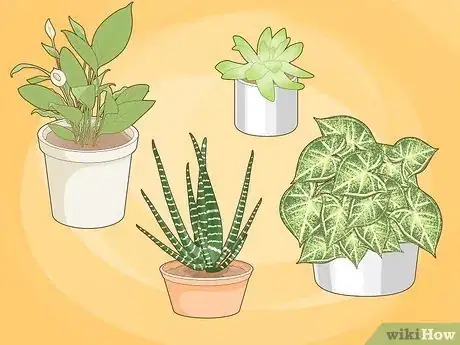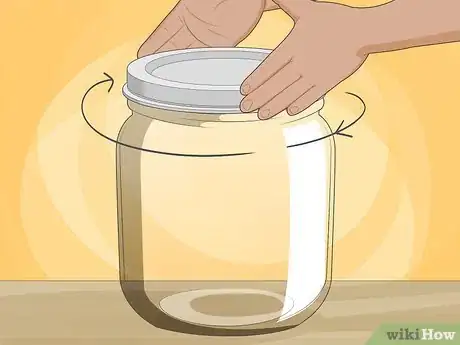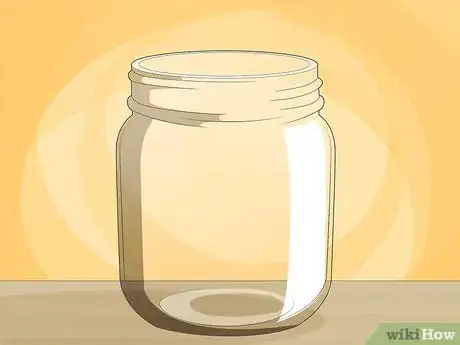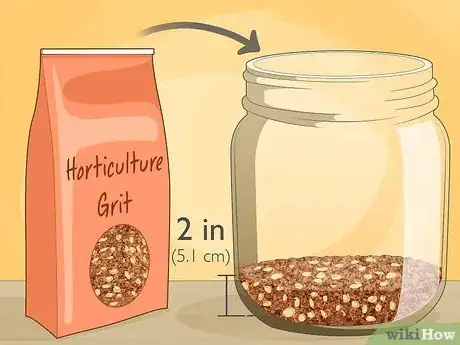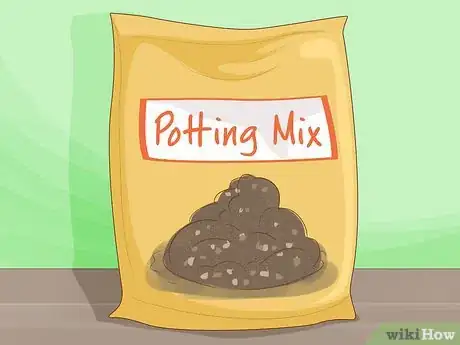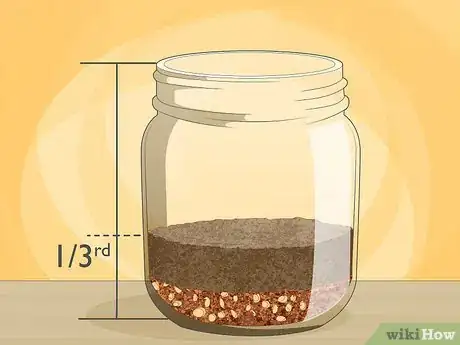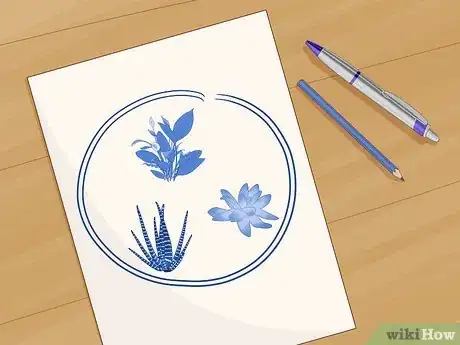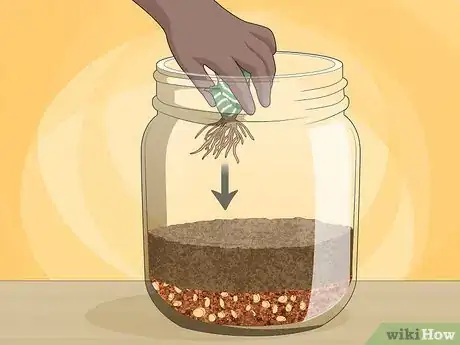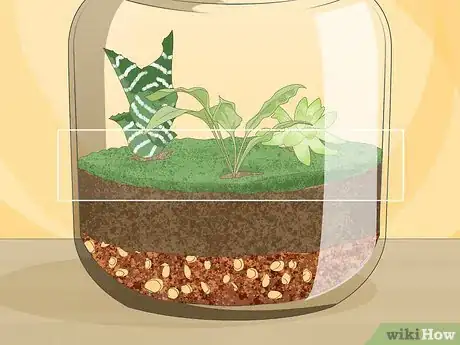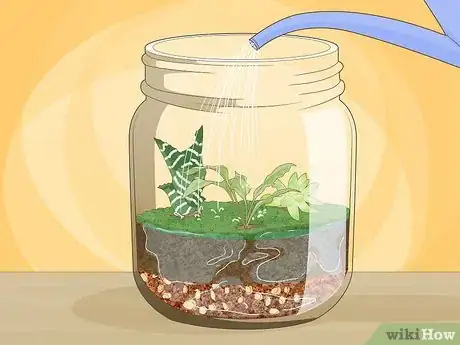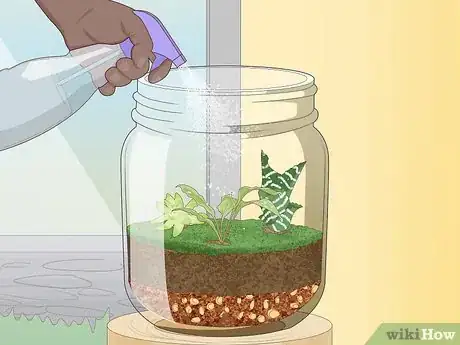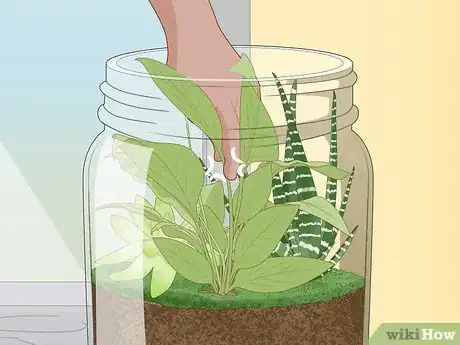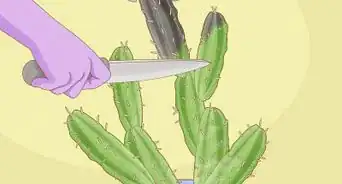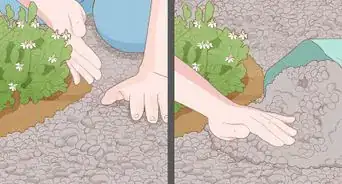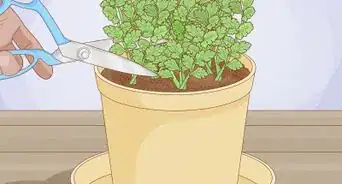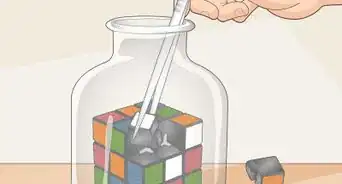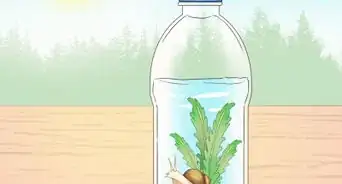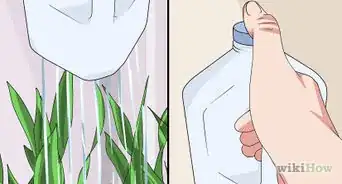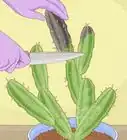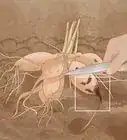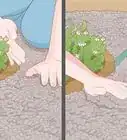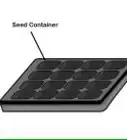This article was co-authored by Ryan Glynn, CPA and by wikiHow staff writer, Megaera Lorenz, PhD. Ryan Glynn is a Plant Specialist, Interiorscaper, and the Founder of Chicago Plants, LLC. He specializes in houseplant care, interior plant-scaping, and gardening. Ryan and Chicago Plants have been featured in several media outlets such as TimeOut Magazine and the Chicago Tribune. Ryan holds a BBA and Master’s degree in Accounting from The University of Wisconsin-Madison.
wikiHow marks an article as reader-approved once it receives enough positive feedback. In this case, several readers have written to tell us that this article was helpful to them, earning it our reader-approved status.
This article has been viewed 550,079 times.
If you don’t have the time or space for an outdoor garden, a glass bottle garden makes a gorgeous and easy-to-maintain alternative! All you need is a large glass bottle, some appropriate planting medium, and a few plants. Once you arrange the plants the way you like them, you’ll just need to water them occasionally and look out for signs of disease or crowding inside the bottle.
Steps
Choosing Your Bottle and Plants
-
1Select plants that require similar growing conditions. If you’re growing multiple plants in a bottle terrarium, it’s important to select species that have similar requirements for light, moisture, and soil type. Choose your plants before you start assembling your bottle garden so that you can plan for their needs.[1]
- For example, if you want to grow succulents, you might choose zebra haworthia, hens-and-chicks, and kalanchoe.[2]
- For a bottle garden with a moister environment, you could go for peace lilies, Fittonia, and Syngonium.
-
2Choose a large, clear glass bottle or jar for your plants. Look for a glass bottle or jar that’s large enough to accommodate the type and number of plants you want to grow. The glass should be clear and colorless to allow in light and let you see the plants easily.[3]
- You can reuse your own containers, such as jam jars or glass milk jugs, or purchase a glass bottle online or from a craft store. If you choose to reuse a bottle, wash it thoroughly before adding plants.
- For easier planting, choose a jar or bottle with an opening large enough to allow your hand in. Otherwise, you can use a long pair of tweezers or chopsticks to insert the plants.
Advertisement -
3Get a bottle that can be closed for a more humid environment. If you’re growing plants that enjoy a moist environment, a closed bottle terrarium is a fun, low-maintenance option. Choose a bottle that you can close with a lid or stopper to prevent evaporation and eliminate the need for frequent watering.[4]
- Ideally, your bottle should have a clear cover, such as a glass lid or stopper. However, a small cork stopper will also work if the bottle allows in enough light otherwise.
Keep in mind: While closed bottle terrariums require less frequent watering than open ones, there’s more of a risk of mold or bacteria building up and infecting your plants.
-
4Opt for an open bottle if your plants need less water. For succulents and other plants that grow in arid environments, an open bottle, jar, or fishbowl-style container is a better option. This will allow water to evaporate more quickly so that your plants don’t get waterlogged.[5]
- A container with straight sides and a wide opening, such as a jar, will allow for faster evaporation.
- If you still want a relatively humid environment but don’t want a completely closed ecosystem, choose a bottle with slanted or curved sides and a narrow opening.
Adding Growth Medium
-
1Add 2 inches (5.1 cm) of horticultural grit to the bottom of the bottle. You’ll need to provide good drainage so that your plants don’t become waterlogged, which can lead to root rot and yellowing leaves.[6] Pour a little horticultural grit or some small, clean pebbles into the bottom of your bottle so that excess water will pool there instead of around your plants’ roots.[7]
- You can buy horticultural grit or planting gravel online or from your local garden supply center.
-
2Purchase a potting soil that’s appropriate for your plants. The type of potting soil you choose will depend on the level of moisture and the types of nutrients your plants require. In general, though, it will need to be well-draining, high in organic content, and free of contaminants that might cause infections in your plants.[8] Research the kind of potting soil that’s best for the plants you plan to grow and buy an appropriate mixture at your local garden center.
- For example, for succulents, use a 50/50 mixture of soil and sand, which won't hold onto any excess moisture.
- For more moisture-loving plants, such as peace lilies, opt for a general-purpose houseplant soil that holds a little moisture while still draining well.
Tip: You can make your own growing medium for most terrarium plants by mixing 1 part peat moss with 1 part soil from your garden. To sterilize it and prevent disease, moisten the soil, cover it with aluminum foil, and heat it in your oven at 200 °F (93 °C) for about 30 minutes. Allow it to cool before using it for planting.[9]
-
3Put in a layer of potting soil until the bottle is 1/3 full. Pour the soil into the bottle on top of the horticultural grit. Break up any lumps with your hands so that the soil is loose and airy.[10]
- It can be helpful to moisten the soil slightly before you pour it in to prevent the sides of the bottle from getting dusty.[11]
Inserting the Plants
-
1Plan how you would like the plants to be arranged in the bottle. Before you add plants to your bottle, consider what layout you think would be most attractive. Set the plants out on a flat surface and space them out similarly to the way they will be in the bottle.[12]
- For the best visibility, put low plants toward the front and taller ones at the back.
-
2Trim your plants and brush off their roots as needed. Inspect each plant carefully for signs of disease, insect infestations, or yellowing leaves. Trim away any damaged or unhealthy-looking foliage. Right before you add each plant to the bottle, carefully brush any excess potting soil or growing medium from their roots.[13]
- If the roots are extremely dense inside the original container, gently tease the root ball apart with your fingers. You can even trim away some of the roots to help encourage new roots to branch out.
-
3Insert each plant into the container one at a time. Use your fingers or a stick to make a depression in the soil where you want each plant. Carefully lower your plants into the bottle and cover their roots with soil. If you’re planting multiple plants, try to leave a little space between them so they have room to spread out.[14]
- If your bottle has a narrow opening, you may need to use tongs to insert the plants. Wrap the plants with paper before putting them in to protect the leaves as they pass through the opening.[15]
- Try to position the plants so their foliage doesn’t touch the sides of the bottle, since moisture will tend to accumulate on the interior walls. Too much moisture can make the leaves rot.
-
4Tamp down the soil around each plant for stability. Once the plants are in place, pat down the soil around the base of each plant. If the container has a wide enough opening, you can do this with your fingers. Otherwise, you will need to use a tool, such as a skewer or stick with a cork on the end.[16]
- Patting down the soil will help remove air pockets and improve contact between the roots and the soil.
-
5Fill the spaces between the plants with moss. You can give your terrarium a prettier, more finished appearance by filling the spaces between the plants. Try adding a layer of moss from your garden to create a dreamy, fairy garden look.[17]
- You can also use peat moss, gravel, polished pebbles, or sand.[18]
Tip: If you like, you can decorate with accessories, such as small figurines or glass gems. Have fun and get creative!
-
6Pour a small amount of water into the bottle so it runs down the sides. Take a watering can and carefully pour in some water along the inner edge of the bottle. Try to get the water to trickle along the wall of the bottle so it doesn’t pour directly onto the plants. Water the soil until it’s damp, but not soggy.[19]
- The curved sides of the bottle will help keep the inside of your container nice and moist between waterings. If you wish, you can put a lid on the bottle to maintain an even more humid environment.
- Alternatively, you can mist the plants instead of watering them. This will help wash off loose potting medium and prevent the soil from getting too sodden, especially if you already moistened it before planting.[20]
Maintaining the Bottle Garden
-
1Place your bottle in a well-lit area out of direct sunlight. Most terrarium plants don’t need direct sun, but they will need some light to grow and stay healthy. Choose a spot in your home that stays bright but won’t allow in enough sun to scorch your plants.[21] East-facing windows often work well for this purpose.[22]
- You can also use a grow light if your home doesn’t have any suitable windows.
-
2Water your plants when the soil becomes dry. Check the soil in your bottle garden occasionally to make sure it doesn’t dry out completely. Mist the plants or add more water as needed. Most terrarium plants do best if their soil is always slightly moist.[23]
- If your bottle terrarium is closed, you probably won’t need to water it for at least 4-6 months.[24]
- If you’re growing succulents, let the soil dry out completely between waterings.
-
3Remove any dead or diseased foliage. During the first few weeks after planting your garden, observe closely for any signs of disease or rot. Quickly remove any dead or rotting plants or leaves to prevent the spread of disease to other plants in the garden. Take out and replace any growing medium that has signs of fungus in it, and add a plant fungicide to stop the infection from spreading.[25]
- Mold can be a sign of an overly humid environment in the bottle. If you’re using a closed bottle for your garden, take off the cover for a few weeks to give it a chance to air out, especially if you notice mold along with fog or condensation on the glass.
-
4Prune your plants if they start to get too big. Plants grown in a bottle garden sometimes need pruning. If your plants are starting to become too tall for their space, trim them back a little to encourage them to grow out instead of up.[26]
- Proactively trim or pinch off just the tips instead of pruning back most of the foliage after the plant has already gotten too tall. This will encourage healthier growth.
- Remember to disinfect your pruning tool with isopropyl alcohol to prevent the potential spread of disease to other plants.
Community Q&A
Did you know you can get answers researched by wikiHow Staff?
Unlock staff-researched answers by supporting wikiHow
-
QuestionWhat are the benefits of bottle planting?
 wikiHow Staff EditorThis answer was written by one of our trained team of researchers who validated it for accuracy and comprehensiveness.
wikiHow Staff EditorThis answer was written by one of our trained team of researchers who validated it for accuracy and comprehensiveness.
Staff Answer wikiHow Staff EditorStaff Answer
wikiHow Staff EditorStaff Answer -
QuestionDo I need to grow a garden from seeds or could I use baby plants?
 wikiHow Staff EditorThis answer was written by one of our trained team of researchers who validated it for accuracy and comprehensiveness.
wikiHow Staff EditorThis answer was written by one of our trained team of researchers who validated it for accuracy and comprehensiveness.
Staff Answer wikiHow Staff EditorStaff Answer
wikiHow Staff EditorStaff Answer -
QuestionCan I use a fish tank to grow plants in?
 wikiHow Staff EditorThis answer was written by one of our trained team of researchers who validated it for accuracy and comprehensiveness.
wikiHow Staff EditorThis answer was written by one of our trained team of researchers who validated it for accuracy and comprehensiveness.
Staff Answer wikiHow Staff EditorStaff Answer
wikiHow Staff EditorStaff Answer
Things You’ll Need
- Large glass bottle or jar
- Horticultural grit or small pebbles
- Potting soil
- Plants
- Moss, pebbles, or sand
- Tongs or tweezers (for bottles with narrow necks)
- Watering can or plant mister
References
- ↑ https://www.gardenersworld.com/how-to/grow-plants/how-to-create-a-bottle-garden/
- ↑ https://www.bhg.com/gardening/houseplants/projects/top-10-succulents-for-home/
- ↑ https://www.gardenersworld.com/how-to/grow-plants/how-to-create-a-bottle-garden/
- ↑ https://extension2.missouri.edu/g6520
- ↑ https://extension2.missouri.edu/g6520
- ↑ http://www.missouribotanicalgarden.org/gardens-gardening/your-garden/help-for-the-home-gardener/advice-tips-resources/pests-and-problems/environmental/overwatering.aspx
- ↑ https://www.gardenersworld.com/how-to/grow-plants/how-to-create-a-bottle-garden/
- ↑ https://extension2.missouri.edu/g6520
- ↑ https://extension2.missouri.edu/g6520
- ↑ https://www.gardenersworld.com/how-to/grow-plants/how-to-create-a-bottle-garden/
- ↑ https://extension2.missouri.edu/g6520
- ↑ https://extension2.missouri.edu/g6520
- ↑ https://extension2.missouri.edu/g6520
- ↑ https://www.gardenersworld.com/how-to/grow-plants/how-to-create-a-bottle-garden/
- ↑ https://extension2.missouri.edu/g6520
- ↑ https://extension2.missouri.edu/g6520
- ↑ https://www.gardenersworld.com/how-to/grow-plants/how-to-create-a-bottle-garden/
- ↑ https://extension2.missouri.edu/g6520
- ↑ https://www.gardenersworld.com/how-to/grow-plants/how-to-create-a-bottle-garden/
- ↑ https://extension2.missouri.edu/g6520
- ↑ https://www.gardenersworld.com/how-to/grow-plants/how-to-create-a-bottle-garden/
- ↑ https://web.extension.illinois.edu/hortihints/0312b.html
- ↑ https://www.gardenersworld.com/how-to/grow-plants/how-to-create-a-bottle-garden/
- ↑ https://extension2.missouri.edu/g6520
- ↑ https://extension2.missouri.edu/g6520
- ↑ https://extension2.missouri.edu/g6520
- ↑ https://extension2.missouri.edu/g6520
